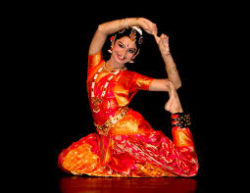Bharatanatyam is one of the 8 forms of dance recognized by Sangeet Natak Academy (National Level Academy for Performing Arts set up by Government of India). It expresses spiritual ideas pertaining to Vaishnavism, Shaktism and Shaivism. This article gives details on its origins, evolution, and important features.
Aspirants would find this article very helpful while preparing for the IAS Exam.
| Aspirants should begin their preparation by solving UPSC Previous Year Question Papers now!!
To complement your preparation for the upcoming exam, check the following links: |
Bharatanatyam – Origin & Evolution

- Bharatanatyam is an important classical dance form in India. It originated in the temples of South India, particularly, Tamil Nadu. It used to be performed by Devadasis, thus it was also known as Dasiattam.
- Believed to be about 2000 years old, information about Bharatanatyam can be found in many ancient texts including Bharata Muni’s Natya Shastra.
- The main source of study for the techniques of body movements in this dance form is Abhinaya Darpana by Nandikesvara (4th – 5th century BCE).
- There is a lot of visual evidence of Bharatanatyam in the stones and pillars of ancient temples.
- The Gopurams of the Chidambaram temple contain many poses of Bharatanatyam.
- The precursor dance form to Bharatanatyam is called Sadir.
- Historical representations of this dance is available from Sangam works like Silappatikaram and Manimekalai.
- Bharatanatyam dance was kept alive by the Devadasis, who were girls dedicated to temples.
- The Brihadeeswara Temple at Thanjavur has been a centre for Bharatanatyam since 1000 CE.
- Many important early artists and gurus of this dance form came from Devadasi families.
- During the British Raj, many colonialists accused the tradition of temple dancing as a front for prostitution.
- Traditional Indian dances were discouraged and an anti-dance movement was launched supported by Christian missionaries, who had their vested interests.
- Lawyer and freedom fighter E Krishna Iyer fought for the revival of Bharatanatyam, and challenged this cultural discrimination by the British government. He was arrested on charges of nationalism.
- The government banned Hindu temple dancing in 1910.
- But, instead of declining, the dance form was revived thanks to the tireless efforts of many artists and activists.
- Artists such as Bala Saraswati, Rukmini Devi Arunadale, etc. revived it and brought it outside the temple as well.
- Their work made the art form ‘respectable’ and spread it outside the traditional dancing community.
- A point to be noted here is that the art form was, in ancient India, treated with great respect, and the association with courtesans began around the 16th century.
- It further fell to disrepute owing to the colonial government’s attitude.
Bharatanatyam – Important Features
Some of the important features and terms associated with Bharatanatyam are described below.
- The three important features of Bharatanatyam are Nritta, Natya and Nritya. For more on this, and the different styles of Bharatanatyam, click on the linked article.
- This dance form is performed by both men and women.
- The costumes worn are bright coloured. Women wear saris and men wear dhotis.
- There is a lot of make-up and bright ornaments used, which accentuate the facial expressions and gestures of the performers.
- The music used in Carnatic classical music, accompanied by instruments such as flute, violin and the Mridangam. There are generally two vocalists, one to sing the song, and the other (generally the Guru of the performer), to recite the rhythmic patterns (Nattuvangam).
- Gestures used in Bharatanatyam are called Hastas or Mudras.
- There is a lot of symbolism in this dance form.
- The dance also includes many asanas found in Yoga.
- Poses of Bharatanatyam are called Karanas.
- Ekaharya – solo artist in Bharatanatyam
- A traditional Bharatanatyam recital involves a series of presentations, and the whole set is called a Margam.
For more on the other classical dances of India, click on the linked article.
Bharatanatyam – Current State of Affairs
- Bharatanatyam is now very popular all over the world.
- Many children in India learn this art form, and dance schools thrive in every part of the country.
- A few of the most popular contemporary Bharatanatyam artists are listed below
- Mrinalini Sarabhai,
- Shobhana,
- Yamini Krishnamurthy,
- Padma Subrahmanyam,
- Chithra Vishveshwaran, etc.
Bharatanatyam UPSC Notes:- Download PDF Here
The above details would help candidates prepare for UPSC 2022.
Frequently asked Questions about Bharatanatyam
What is the origin of Bharatnatyam?
What is the old name of Bharatanatyam?
Related Links
| IAS Salary | UPSC Syllabus |
| Economic Survey | Indian Foreign Service Ranks |
| History of Modern India PDF | NAPCC |
| Class 12 History Notes | Article 52 |

Comments